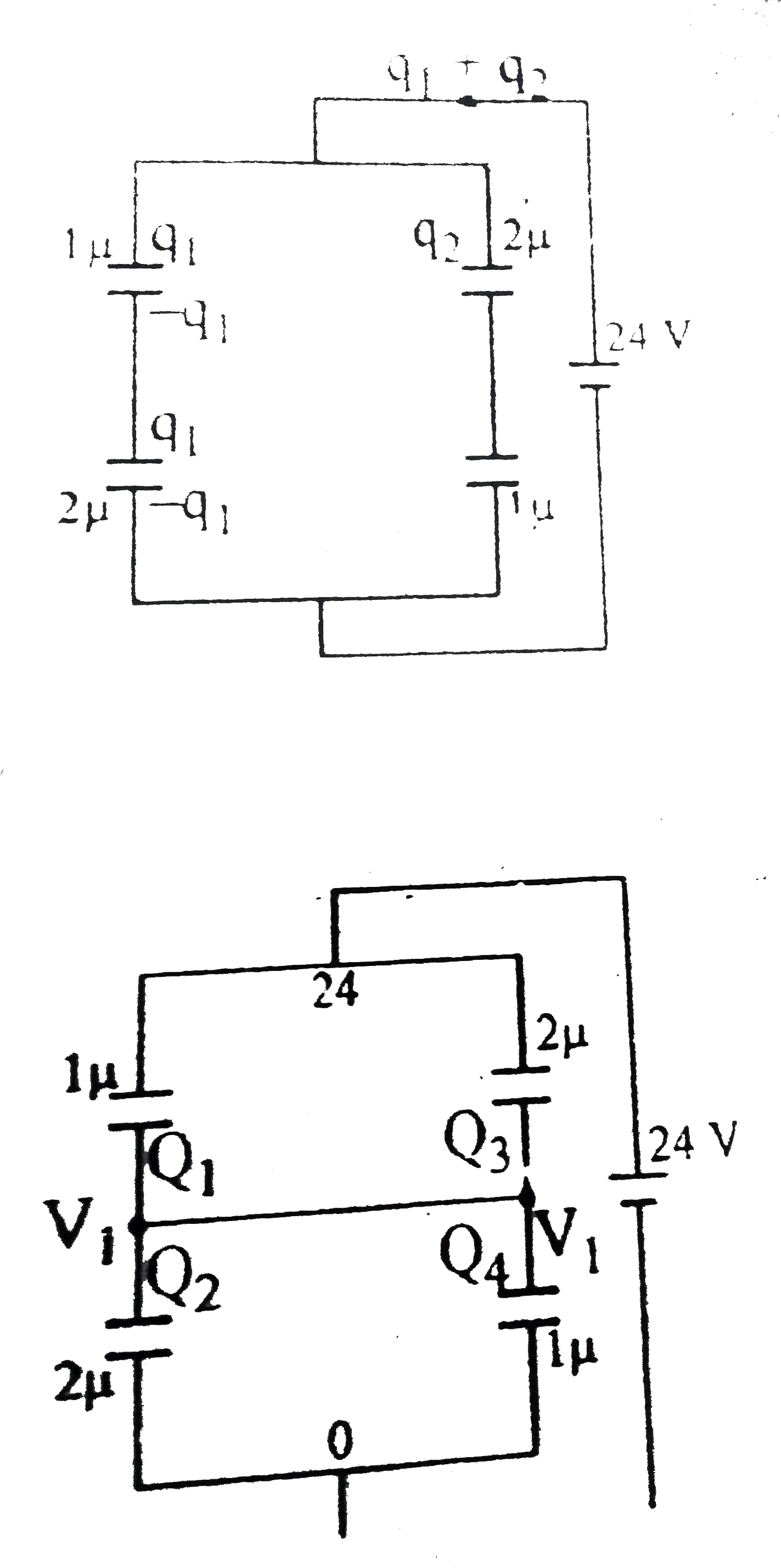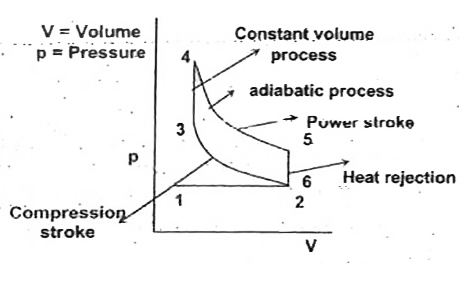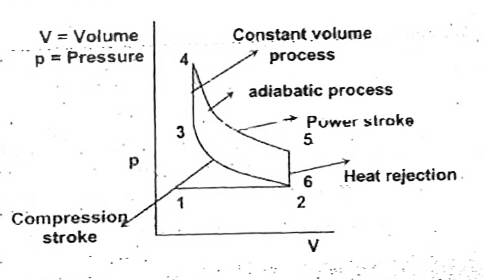An electrometer is charged to 3 kV. Then the electrometer is touched with a neutral metal ball, mounted on an isulating rod and then the metal ball is taken away and earthed The process is done for 10 times and finally the electrometer reads 1.5 kV. After this, at least how many times must the above process be repeated in order that the electrometer reads less than 1 kV?
The correct Answer is:12
Initially q1=24(23μf)=16μC&q2=16μC
Finally 
(V1−24)×1+(V1−0)×2+(V1−24)×2+(V1−0)×1=0
V1(1+2+2+1)−24×3=0⇒V1=24×36=12V
Q1+Q2=(12−24)×1+(12−0)×2=−12+24=12μC
Q3+Q4=(12−24)×2+(12−0)×1=−24+12=−12μC
Initial net charge on plates left of S=0
Final net charge on plates left of S=Q1+Q2=12μC
Charge flowing through S=12μC towads left
Alternative −2×12×1×12=0=−12=12μC
Topper's Solved these Questions
- MASTER PRACTICE PROBLEMBook:BANSALChapter:MASTER PRACTICE PROBLEMExercise:Additional topic
Explore 70 Videos
- MASTER PRACTICE PROBLEMBook:BANSALChapter:MASTER PRACTICE PROBLEMExercise:Multiple objective
Explore 131 Videos
- FLUID MECHANICSBook:BANSALChapter:FLUID MECHANICSExercise:PYQS AIEEE
Explore 10 Videos
- SEMICONDUCTORSBook:BANSALChapter:SEMICONDUCTORSExercise:CBSE Question
Explore 32 Videos
Similar Questions
Answer the following:
(a) The top of the atmosphere is at about 400 kV with respect to the surface of the earth, corresponding to an electric field that decreases with altitude. Near the surface of the earth, the field is about 100Vm−1. Why then do we not get an electric shock as we step out of our house into the open? (Assume the house to be a steel cage so there is no field inside!)
(b) A man fixes outside his house one evening a two metre high insulating slab carrying on its top a large aluminium sheet of area 1m2. Will he get an electric shock if he touches the metal sheet next morning?
(c) The discharging current in the atmosphere due to the small conductivity of air is known to be 1800 A on an average over the globe. Why then does the atmosphere not discharge itself completely in due course and become electrically neutral? In other words, what keeps the atmosphere charged?
(d) What are the forms of energy into which the electrical energy of the atmosphere is dissipated during a lightning? (Hint: The earth has an electric field of about 100Vm−1 at its surface in the downward direction, corresponding to a surface charge density =10−9Cm−2. Due to the slight conductivity of the atmosphere up to about 50 km (beyond which it is good conductor), about +1800C is pumped every second into the earth as a whole. The earth, however, does not get discharged since thunderstorms and lightning occurring continually all over the globe pump an equal amount of negative charge on the earth.)
View SolutionSince 1891 lighting lamps have been manufactured in the Netherlands. The improvement today in comparison to the first lamp is enormous , especially with the intorduction of the gas discharge lamps. The life- time has increased by orders of magnitude . the colour is also an important aspect. Rare earth metal compunds like CeBr3 are now included to reach a colour temperature of 6000K in the lamp the compounds are ionic solids at room temperature , and upon heating they sublime partially to give a vapour of neutral metal halide molecules . To achieve a high vapour pressure, the sublimation enthalpy should be as low as possible.
Calculate the enthalpy of sublimation fo CsCeBr4 (in integers) Use the Born-Lande formula for all steps in the process and report the separate energies also (be aware of the signs). The CeBr−4 anion is a teteahedron and in which the ratio between the edge and the destance between a corner of the tetrahedron and the centre of gravity (body - radius) amounts to (2√6)/3=1.33 . The Born exponent of the CsBr is 11. The radius of Cs is 0.181 nm.
View Solution
Knowledge Check
To move an airplane through the air, thrust is generated by some kind of propulsion system. Beginning with the Wright brothers' first flight, many airplanes have used internal combustion engines to turn propellers to generate thrust. Today, most general aviation or private airplanes are powered by internal combustion (IC) engines, much like the engine in your family automobile. When discussing engines, we must consider both the mechanical- operation of the machine and the thermodynamic processes that enable the machine to produce useful work. We consider the thermodynamics of a four-stroke IC engine.

Figure shown represents such a cycle which is used in all Internal combustion engines. The figure shows a p-V diagram of the cycle. Using the engine stage numbering system, we begin at the lower left with Stage 1 being the beginning of the intake stroke of the engine. The pressure is near atmospheric pressure and the gas volume is at a minimum. Between Stage 1 and Stage 2 the piston is pulled out of the cylinder with the intake valve open. The pressure remains constant, and the gas volume increases as fuel/air mixture is drawn into the cylinder through the-intake valve. Stage 2 begins the compression stroke of the engine with the closing of the intake valve. Between Stage 2 and Stage 3, the piston moves back into the cylinder, the gas volume.decreases, and the pressure increases because work is done on the gas by the piston. Stage 3 is the beginning of the combustion of the fuel/air mixture. The combustion occurs very quickly and the volume remains constant. Heat is released during combustion which increases both the temperature and the pressure, according to the equation of slate. Slage 4 begins the power stroke of the engine. Between Stage 4 and Stage 5, the piston is driiven towards the crankshaft, the volume in increased, and the pressure falls as work is done by the gas on the píston. At Stage 5 the exhaust valve is opened and the residual heat in the gas is exchanged with the surroundings. The volume remains constant and the pressure adjusts back to atmospheric conditions. Stage 6 begins the exhaust stroke of the engine during which the piston. moves back into the cylinder, the volume decreases and the pressure remains constant. At the end of the exhaust stroke, conditions have returned to Stage 1 and the process repeats itself. During the cycle, work is done on the gas by the plston between stages 2 and 3. Work is done by the gas on the piston between stages 4 and 5. The difference between the work done by the gas and the work done on the gas is the area enclosed by the cycle curve and is the work produced by the cycle. The work times the rate of the cycle (cycles per second) is equal to the power produced by the engine.
Consider that the above diagram represents an ideal such cycle then choose the incorrect statement fora corresponding real cycle.AThe area of the p-V diagram for the real cycle will be lesser than that for ideal cycle.BThe shape of the p-V diagram for the real cycle will be similar to the corresponding ideal cycle.CThe power produced by the engine for an ideal cycle will be greater than that produced by corresponding real cycle.DThe shape of the p-V diagram for the real cycle will not be similar to the ideal cycle.A large negatively charged object was placed on an insulated table. A neutral metallic ball rolled straight toward the object but stopped before touching it. A second neutral metallic ball rolled along the same path as the first ball. Struck the first ball driving it a bit closer to the negatively charged object and stopped. After all stopped rolling, the first ball was closer to the negatively charged object than the second ball. At no time did either ball touch the charged object. which statement is correct concerning the final charge on each ball ?
AThe first ball is positive and the second negativeBThe first ball is negative and the second positiveCBoth balls remain neutralDBoth balls are positiveElectrolysis is the process in which electrical energy is converted to chemical energy. In electrolytic cell, oxidation takes place at anode and reduction at cathode. Electrode process depends on the electrode taken for electrolysis. Amount of substance liberated at an electrode is directly propertional to the amount of charge passed through it. The mass of substance liberated at electrode is calculated using the following relation :
m=ItE96500
Here, E represents the equivalent mass and 96500 C is called the Faraday constant. Faraday (96500 C) is the charge of 1 mole electron, i.e., 6.023×1023 electrons, it is used to liberate one gram equivalent of the substance.
How many faradays are required to reduce 1 mol BrO−3 to Br− ?A3B5C6D4
Two plane parallel conducting plates 1.5×10−2m apart are help horizontally one aove the other in air. The upper plate is maintained at positive potential of 1.5 kV while the other plate is earthed. Calculate the number of electorns which must be attached to a small oil drop of mass 4.9×10−15kg between the plates to maintain it at rest. If the potential of upper plate is suddenly changed to −1.5 kV, what is the initial acceleration of the charged drop ? Also obtain the terminal velocity of the drop if its radius is 5×10−6m and coefficient of viscosity of air is 1.8×10−5N−s/m2. Assuming that the density of air is negligible in comparison with that of oil.
View SolutionFollowing are the conditions for selecting Accounts Manager in an organization. The candidate must -
(i) be a graduate Commerce with minimum 55 percent marks
(ii) be a post graduate in Commerce minimum 50 percent marks
(iii)have post qualification work experience of atleast three years in the account department in an organization.
(iv) not be less than 25 years and not more than 35 years old as on 1.5.2008
(v) have secured at least 40 percent marks in the selection process In the case if a candidate satisfies all other criteria except -
(A) at (ii) above but has work experience of at least four years as Assistant Accounts Manager in an organization. His/her case is to be referred to GM-Accounts of the organization
(B) at (iii) above but has successfully completed CA/ICWA, the case is to be referred to Director Finance.
In each question below details of one candidate is given You have to take one of the following courses of action in each case based on the information provided and the conditions and sub conditions given above and mark the number of that course of action as your answer. You are not to assume anything other than the information provided in each case. All the cases are given to you as on 1.5.2008.
Ashok Pradhan was born on 3rd May 1979. He has secured 42 percent marks in the selection process. He has been working in the accounts department of an organization for the past four years after completing his post graduation in Commerce with 62 percent marks. He has secured 54 percent marks in his graduation in Commerce.
View SolutionTo move an airplane through the air, thrust is generated by some kind of propulsion system. Beginning with the Wright brothers' first flight, many airplanes have used internal combustion engines to turn propellers to generate thrust. Today, most general aviation or private airplanes are powered by internal combustion (IC) engines, much like the engine in your family automobile. When discussing engines, we must consider both the mechanical- operation of the machine and the thermodynamic processes that enable the machine to produce useful work. We consider the thermodynamics of a four-stroke IC engine.

Figure shown represents such a cycle which is used in all Internal combustion engines. The figure shows a p-V diagram of the cycle. Using the engine stage numbering system, we begin at the lower left with Stage 1 being the beginning of the intake stroke of the engine. The pressure is near atmospheric pressure and the gas volume is at a minimum. Between Stage 1 and Stage 2 the piston is pulled out of the cylinder with the intake valve open. The pressure remains constant, and the gas volume increases as fuel/air mixture is drawn into the cylinder through the-intake valve. Stage 2 begins the compression stroke of the engine with the closing of the intake valve. Between Stage 2 and Stage 3, the piston moves back into the cylinder, the gas volume.decreases, and the pressure increases because work is done on the gas by the piston. Stage 3 is the beginning of the combustion of the fuel/air mixture. The combustion occurs very quickly and the volume remains constant. Heat is released during combustion which increases both the temperature and the pressure, according to the equation of slate. Slage 4 begins the power stroke of the engine. Between Stage 4 and Stage 5, the piston is driiven towards the crankshaft, the volume in increased, and the pressure falls as work is done by the gas on the píston. At Stage 5 the exhaust valve is opened and the residual heat in the gas is exchanged with the surroundings. The volume remains constant and the pressure adjusts back to atmospheric conditions. Stage 6 begins the exhaust stroke of the engine during which the piston. moves back into the cylinder, the volume decreases and the pressure remains constant. At the end of the exhaust stroke, conditions have returned to Stage 1 and the process repeats itself. During the cycle, work is done on the gas by the plston between stages 2 and 3. Work is done by the gas on the piston between stages 4 and 5. The difference between the work done by the gas and the work done on the gas is the area enclosed by the cycle curve and is the work produced by the cycle. The work times the rate of the cycle (cycles per second) is equal to the power produced by the engine.
Choose.the correct statement.
View SolutionThere are three unchanged identical metallic spheres 1,2and3 each of radius r and are placed at the verticles of an equlilateral triangle of side d.A charged metallic sphere having equal q of same radius r is touched to sphere 1 after some time it is taken to the location of sphere 2 and is touched to it ,then it is taken far away form sphere 1,2,3 after that the sphere 3 is grounded the charge on sphere 3 is (neglect electrostatic induction by assuming d>>2r)
View SolutionIn a photoelectric setup, a point source of light of power 3.2×10−3 W emits monoenergetic photons of energy 5.0 eV. The source is located at a distance of 0.8 m from the center of a stationary metallic sphere of work function 3.0 eV and of radius 8.0×10−3m. The efficiency of photoelectron emission is 1 for every 106 incident photons. Assume that the sphere is isolated and initially neutral and that photoelectrons are instantaneously swept away after emission.
Q. It is observed that photoelectron emission stops at a certain time t after the light source is switched on. It is due to the retarding potential developed in the metallic sphere due to lift over positive charged. The stopping potential (V) can be represented as
View Solution

